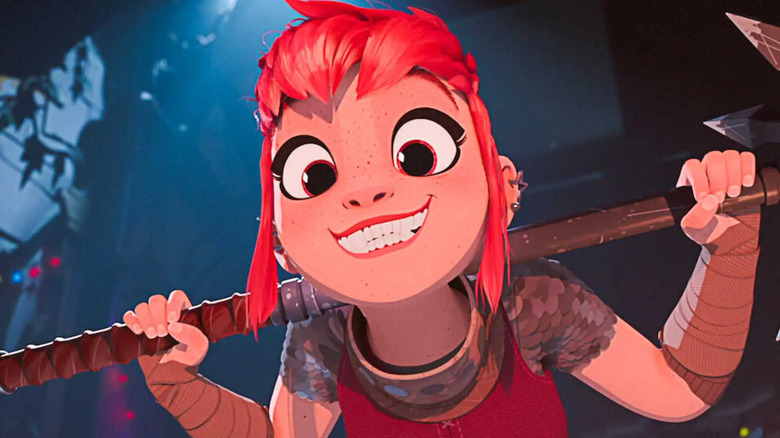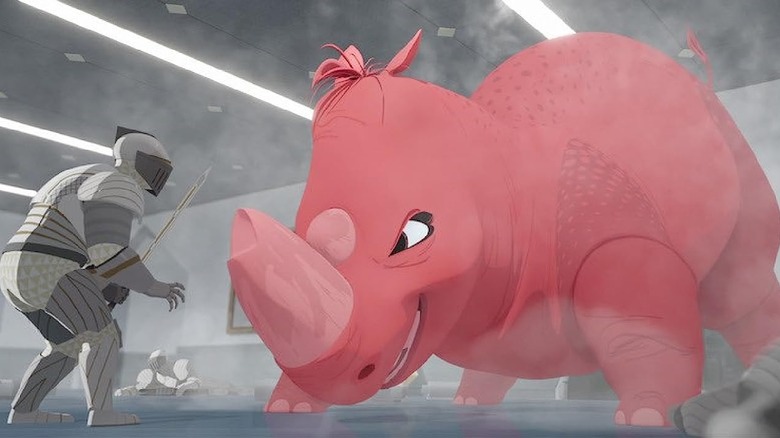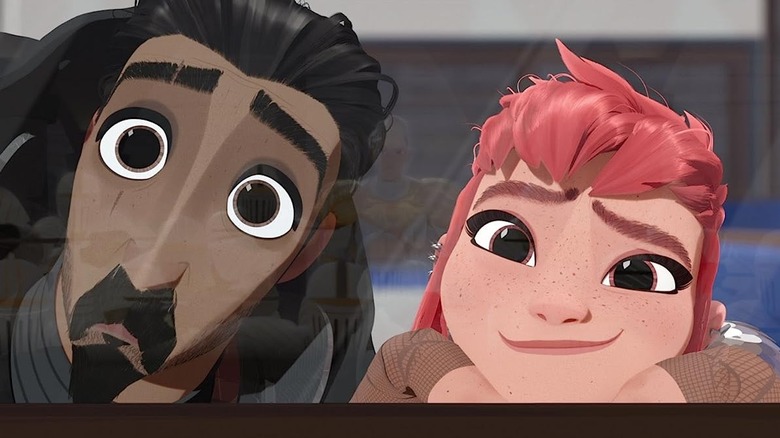Netflix's Nimona Had A Long, Hard Road To The Screen
"Nimona" takes place in a stylishly frenetic 2D-3D animated medieval-futuristic setting that's like a cross between King Arthur's Camelot and Los Angeles from "Blade Runner." In point of fact, this notion of being multiple things all at once is one of the definitive motifs of ND Stevenson's cheeky, rebellious creation, and not just in terms of the story. "Nimona" began as a webcomic Stevenson developed in college before becoming a graphic novel in 2015. That same year, 20th Century Fox Animation acquired the screen rights for an animated feature film adaptation, with the intention of releasing it in 2020.
Much like its shape-shifting namesake, the "Nimona" movie was constantly changing over the course of its production. Patrick Osborne ("Feast") was originally set to direct the film for Fox's Blue Sky Studios, with Marc Haimes ("Kubo and the Two Strings") writing the script. Then, in March 2019, Disney finalized its acquisition of Fox media assets, throwing the future of not just "Nimona" but Fox's entire animation division into question. After the release date was pushed back, Osborne left the project in March 2020 and was replaced by longtime Blue Sky animator Nick Bruno and storyboard artist Troy Quane ("Enchanted," "Hotel Transylvania") — a team who was then fresh off directing the studio's "Spies in Disguise."
Of course, just as the film had gotten back on its feet, the whole world went on lockdown in response to COVID-19 that same month. As if that wasn't enough, Disney shut down Blue Sky less than a year later, at which point "Nimona" was 10 months away from being finished (which, in terms of how long it takes to make an animated film without exhausting your animators, is not very long at all). Thankfully, however, this story has a happy ending.
A shapeshifter in more ways than one
Where it's apparent something like Pixar's "The Good Dinosaur" changed hands mid-production on its way to the screen when you watch it, that's not the case with "Nimona." Instead, the film, which was revived by Annapurna Pictures and Netflix after Disney closed Blue Sky, plays like a re-imagining of ND Stevenson's source material guided by a singular creative vision. Perhaps even more importantly, the film — which centers on the noble aspiring knight Ballister Boldheart (Riz Ahmed) and his newly self-appointed sidekick, the anarchic shape-shifter Nimona (Chloë Grace Moretz) — remains true to the original comics' themes about the fluid nature of identity, the ways history can be rewritten, and the need for institutions to evolve with the times. It's also an explicitly queer movie, which may've well not been the case had it remained under the House of Mouse's supervision.
Stevenson, as it were, agrees with me. "I always knew that things were going to change about the story, and that they should change because I made the comic that I set out to make, and now it was going to be something new," he told NPR. "It was going to do its own little shapeshift, if you will, and become a whole new thing." Stevenson added:
"But Nimona [the character] to me really felt like what it is about the story that makes it special. So in a lot of ways it's very recognizable. It has a lot of familiar elements of heroes, villains, monsters, this medieval world, but it's set in the future with some tropes associated with both of those kinds of extremes."
Nimona is right on time
It's not exactly difficult to see how ND Stevenson was reacting to his upbringing with "Nimona." "I come from a very conservative and religious background that I found very constraining growing up," he noted. "And when I became an adult, there was a lot of figuring out what I believed about the world." Stevenson continued:
"So the comic is in many ways a reaction to that. It's asking about, if there's someone who feels that they are definitely the hero, that they can do no wrong, that they are in pursuit of a righteous cause, and they use that as an excuse to dehumanize others. Is it really righteousness? Are the heroes really heroes? And are the villains really villains?"
More than that, "Nimona" afforded Stevenson an artistic outlet for exploring his queer identity years before he came out as trans and non-binary in 2020; it was essentially to him what "The Matrix" was to the Wachowski sisters. And much like Nimona helped Stevenson when he was younger, he hopes the movie version of his comics can speak to our current predicament, in which members of the LGBTQIA+ community (especially trans individuals) in the U.S. are battling a record number of bills targeting their rights.
"We are seeing this very reactionary backlash, this moral panic about people like me who are just living our lives," said Stevenson. He added:
"I think that that is at the heart of where the story came from. But it's also something that I think that kind of gained a new meaning in the telling of this story. And so I'm really hoping that the story can start constructive conversations about how to love the people in our lives and how to be the person that they need us to be."
"Nimona" is streaming on Netflix.


